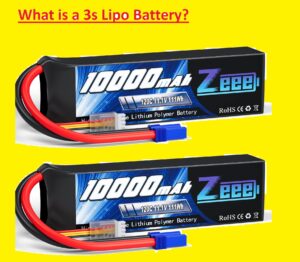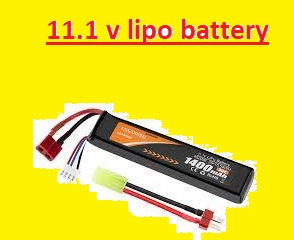Hi friends welcome to the new post. In this post, we will discuss the 2024 Comprehensive Guide on 3s lipo Battery & its Applications, Pros & Cons. The need for effective and high-power batteries is increasing. The most common battery is the 3s Lipo battery. In this post, we will cover the details of 3S Lipo batteries, working features, and other parameters. So let’s get started with 3s lipo battery
What is a 3s Lipo Battery?
The 3S lipo battery is lithium polymer battery for RC uses and electronics. The 3S is a battery pack with three series of connected cells.
The overall voltage for this battery is 11.1 volts (3 cells x 3.7 volts), with each cell having 3.7 volts.
This voltage is balanced value offers good power to operate different RC models.
This battery is neither unimpressive nor overbearing, offer good operation and easy to use and best for RC users
How Does a 3s Lipo Battery Work?
if the 3s Lipo battery is charged lithium ions are negative from the positive electrode and get discharged and reverse the charging process. This is the process of battery energy storing and releasing
Advantages of 3s Lipo Batteries
It is best for starters since their high energy density helps to store enough energy in small areas. It covers longer runtime for RC cars, drones, and some other electrical devices.
it has a good discharge rate helps to generate steady power generation and high power operation.
This battery is less weight than other nickel batteries reducing the total weight of devices.
Disadvantages of 3s Lipo Batteries
- It has safety concerns like overcharging, and mishandling that can affect operations and can casues explode.
- There are certain types of chargers used for battery chargers so use them according to instructions to avoid any damage.
- it can casues degradation that is due to storage conditions and temperature.
Applications of 3s Lipo Batteries
- 3S lipo batteries are used to power RC and drone operators as they are less weight have high energy output and can handle high discharge rates.
- These batteries are used in automotive for high energy efficiency and it an easily handle high-power motors.
- It used in small electronic devices like mobile phones, laptops, and other small devices
Maintaining of 3s Lipo Batteries
- If the battery is not in use store it in dry and cool places and save it from extreme temperatures.
- Try to use the proper charger and not leave the battery unattended when the chargers are connected.
- When battery is damaged recycle it accurately
Understanding LiPo Battery Numbers
LiPo batteries, that is full-form Lithium Polymer batteries, is the main part of devices like laptops, RC vehicles mobile phones, and other applications. The numbers mentioned on batteries are as
- Voltage (V): The working voltage of this battery is the potential difference between positive and negative points. LiPo comes with different voltage values 3.7V (one cell) and 7.4V (2 cells).
- Capacity (mAh): This battery explains the amount of electric charge that is stored and used. its measuring unit is mAh and defines the curent used by the battery. Normally mAh defines the working duration of the battery before getting recharged.
For instance, the LiPo battery is labeled as 3.7V 2200mAh. here
- The voltage value is 3.7V, which means it is a cell battery
- 2200mAh, which shows that the battery can provide 2200 milliampere-hours of current.
What is LiPo Battery Voltage?
A LiPo cell comes with a nominal volt value of 3.7 volts. For a 7.4 volt battery, that means there are 2 cells in a series combination connected. it is normally heard that a “2S” battery pack are two cells in a Series.
voltage ranges for different LiPo battery packs:
| Number of Cells | Voltage Range |
|---|---|
| 1S | 3.7V |
| 2S | 7.4V |
| 3S | 11.1V |
| 4S | 14.8V |
| 5S | 18.5V |
| 6S | 22.2V |
11.1 v lipo battery
The 11.1v LiPo battery has three cell packs. Every cell comes with 3.7 volts and the total voltae are 11.1 volts. its charge voltae is 4.2 volts so 3 cell LiPo battery has 12.6 volts in complete charge. The minimum voltage for 3 3-cell lipo batteries is 9 volts. IF the battery gets discharged below 9 volts it is damaged.
This battery used in airsoft guns, planes remote control cars etc
3s lipo rc battery
It is a rechargeable lithium battery that is used in radio-controlled vehicles. Its nominal voltae is 11.1 and has three single polymer cells. It is Used from 500 mAh to 5000 mAh.
features of a 3S LiPo RC battery:
- it comes with high energy density so can store high energy in small places. The best to use RC vehicles that need high power such as helicopters and racing cars.
- It has longer working duration about 200 charge cycles
- It gets discharged at high power so best to use it for high-speed uses.
Key Knowledge of AAA Battery Voltage, Capacity, Size & Dimensions
How Much Does a Car Battery Cost? 2024 Detailed Guide
CR1/3N Battery Equivalent To Replace: 1/3N vs 357 vs 2L76 | 2023 Detailed Guide
What is LiPo battery Cell Count?
The cells used of Lipo battery is cells connected in a series combination in the battery pack. Cell count is S like lipo battery has two cells in series and 3S has 3 cells.
Battery voltage is also based on cell counts. Every lipo cell provdies 3.7 volts. 2s battery has 7.4 volts and 3s has 11.1 volts. Capacity of cells according to cell count.
Capacity is measured in mAh and energy stored in the battery. Cell count does not have any effect on battery capacity.
What is LiPo Battery Capacity?
Battery capacity is the amount of energy stored and measured in milliampere hours or ampere hours. Capacity is about 28000 Mah,
What is Discharge Rating (C Rating)?
The C rate is a measurement of the rate over which the battery is discharged according to high capacity. The 1C rate is the discharger current that discharges the battery in one hour. In case of a capacity of 100 Amp-hrs, a discharge current of 100 Amps
discharge C rate=Discharge current/Battery capacity
Such as if a 3.7v 1000mAh LiPo battery discharges 5000mA then its
discharge C rate=5000mA/1000mAh=5C.
relationship between C rating and discharge time:
| C Rating | Discharge Time |
|---|---|
| 1 | 1 hour |
| 2 | 30 minutes |
| 3 | 20 minutes |
| 4 | 15 minutes |
| 5 | 12 minutes |
Internal Resistance and Its Effects on LiPo Batteries
Internal resistance is the resistance of the battery that affects current flow. Its unit is milliohms and its value is according to the electrode connected and electrolyte and design of the battery. The battery works well if has less resistance.
Due to less resistance there is less power loss when the battery is discharged. it decreases battery working time and high discharge rate.
Affect on LiPo Battery
- For less inner resistance battery working life reduces.
- It is a high curent for low resistance
- it produces heat.
factors that can take part in high internal resistance in LiPo batteries are
- The inner resistance of the battery increases.
- Any damage to the battery can increase inner resistance.
- Overcharing or underscoring also affects inner resistance.
How to Minimize Internal Resistance
- Use high-quality materials.
- Design the battery for low resistance.
- Avoid damage.
- Inspect the battery regularly.
- Store the battery properly.
- Use a high-quality charger.
Internal Structure of a Lithium Polymer Battery
- 4 components of this battery are a positive electrode, a negative electrode, a seperator, and an electrolyte.
- The seperator can be of a polymer such as a microporous film of polyethylene, if the cell has a liquid electrolyte will be polymer.
- The positive electrode is divided into three parts tha is lithium-transition-metal-oxide (LiCoO2 or LiMn2O4), a conductive additive, and a polymer binder of poly(vinylidene fluoride) (PVDF).
- The negative electron also has three parts with replacing carbon with lithium-metal-oxide. The main difference between lithium polymer cell and lithium-ion cell is the physical layout of electrolytes iPo cells use dry solid, gel-like while Li-ion cells use liquid electrolytes.
Read Also:
- l1154f vs LR44: Top Picks for LR44 Battery Equivalents
- CR1220 Battery Equivalent, Features, Specification, Chat and Application
- What Battery is Equivalent to sr920sw
- 2024 Detailed Guide About Kobalt 40v Battery Replacement
- CR1620 Battery Equivalent and Replacements – List Buying Options
- SR621SW Battery Equivalent: AG1, 364/363, 377 IR621 2023 Guide
- Key Knowledge of AAA Battery Voltage, Capacity, Size & Dimensions
Faqs
How do I know what size LiPo battery to buy?
Here are some factors to study when choosing a LiPo battery size:
- Lipo battery comes for different voltage values 3s to 6s. The voltage of the battery is the power output of the battery
- Battery capacity is measured in mAh. That defines how much time a battery can operate
- Lipo batteries come in differnt sizes. dimensions of the battery will define if it will fit in your device..
What is a safe low voltage for 3S LiPo?
A safe less voltage for a 3S LiPo battery is 3.2 volts per cell. That shows that the total voltage of the battery must not low than 9.6 volts. If the battery is discharged below this voltage, it can be damaged.
How many amps do you charge a 3S LiPo at?
The amps values that you charge a 3S LiPo at are based on the capacity of the battery. The basic principle is to charge a LiPo battery at a rate of 1C. For instance, if you have a 1000mAh battery, you should charge it at a rate of 1 amp.
How many volts should a 3S LiPo charge to?
A 3S LiPo battery must be charged to 4.2 volts per cell. That means that the total voltage of the battery must be 12.6 volts. If the battery is charged over this voltage value get damaged
CR123 vs CR123A Batteries: Which Ones Are Better? 2023 Guide
Who Makes/Sells Autocraft Gold Battery | Price, warranty & Where To Buy 2023 Detailed Guide
What is the maximum voltage for a 3 cell LiPo battery?
The safe voltage range for a standard lipo battery cell is 3.2v to 4.2v. Volts less than 3.2v and the battery can be permanently damaged. Larger than 4.2v and chances of a battery bursting into flames.
What voltage is 7.4 v LiPo?
A 7.4V lipo in full discharged after reaching six volts and full charge is 8.4 volts. For longer battery life it can not be less than 7.4 volts
What voltage is a LiPo battery dead?
The voltage started from 4.2 maximum and lost to 3.7V for battery life. When volts become 3.4V the battery is dead and at 3.0V the cutoff circuitry disconnects the battery
What is the max charge on a 7.4 V LiPo battery?
The highest charging voltage is 4.20V per cell. there are 2 cells in series for this pack highest volts for this pack is 8.40V.
What voltage is a full charge 12V LiPo?
A full-charge 12V LiPo battery will have a voltage of 13.3-13.4v. .
What is the maximum charge voltage?
The maximum charge voltage for a battery is the voltage that the battery must not be charged above. For a LiPo battery, the maximum charge voltage is 3.2v to 4.2v volts per cell.
What is the maximum voltage of a 12v battery?
The maximum voltage of a 12v battery is 14.7V
What is a good voltage for a 12v battery?
A good voltage for a 12v battery is 12.6 volts.







